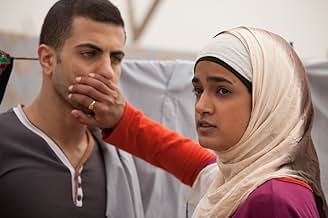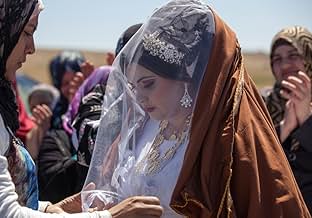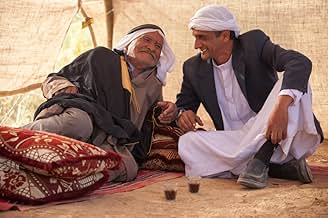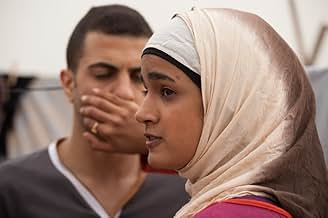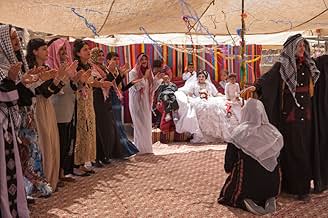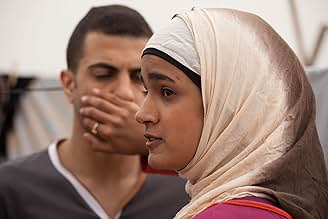Agrega una trama en tu idiomaWhen their entire lives shatter, two Bedouin women struggle to change the unchangeable rules, each in her own individual way.When their entire lives shatter, two Bedouin women struggle to change the unchangeable rules, each in her own individual way.When their entire lives shatter, two Bedouin women struggle to change the unchangeable rules, each in her own individual way.
- Dirección
- Guionista
- Elenco
- Premios
- 15 premios ganados y 19 nominaciones en total
Hitham Omari
- Suliman
- (as Haitham Omari)
Khadija Al Akel
- Tasnim
- (as Khadija Alakel)
- Dirección
- Guionista
- Todo el elenco y el equipo
- Producción, taquilla y más en IMDbPro
Opiniones destacadas
Sufat Chol (2016) is an Israeli movie that was shown in the U.S. with the title Sand Storm. It was written and directed by Elite Zexer.
The film takes place in an area of Israel where the Bedouins live. (Truth in reviewing--I didn't know there were Bedouins in Israel. However, they make up 3.5% of the population.) The film is in Arabic, and no Jewish Israelis appear in it. There is one mention of houses being bulldozed, but that's the only sense that there's a majority population outside the village.
Lamis Ammar plays Layla, a intelligent young woman, who is in love with "someone from a different tribe." That's not OK.
Ruba Blal portrays Jalila, Layla's mother. Hitham Omari is Suliman, Layla's father and Jalila's husband.
Matters are a little confusing in the beginning, as a pickup truck arrives at a home. The load in the pickup truck is a new bed. It signals to us that Suliman has taken a second wife. The bed is their wedding bed.
We know that, for Muslims, having more than one wife is normative. However, as the plot develops, it's clear that other matters that are considered normative appear unacceptable by our standards.
In fact, the rules and restrictions of the village appeared medieval to me. I considered whether this was an Israeli propaganda film, showing to the world how primitive the Bedouins are. However, a close friend, who is knowledgeable about these matters, assured me that this is the reality of Bedouin life in Israel.
The restrictions the mother and daughter face are disturbing and grim. However, that's what makes up the plot of the film.
This movie worked well on the small screen. It has an anemic IMDb rating of 6.8. I wondered why this important movie had such a low rating. When I checked the demographics it became clearer. Men rated it 6.7, while females rated it 7.0. (As usual, male raters outnumbered female raters. In this case, it was two to one.)
I think even 7.0 is too low for this movie. I rated it 9.
The film takes place in an area of Israel where the Bedouins live. (Truth in reviewing--I didn't know there were Bedouins in Israel. However, they make up 3.5% of the population.) The film is in Arabic, and no Jewish Israelis appear in it. There is one mention of houses being bulldozed, but that's the only sense that there's a majority population outside the village.
Lamis Ammar plays Layla, a intelligent young woman, who is in love with "someone from a different tribe." That's not OK.
Ruba Blal portrays Jalila, Layla's mother. Hitham Omari is Suliman, Layla's father and Jalila's husband.
Matters are a little confusing in the beginning, as a pickup truck arrives at a home. The load in the pickup truck is a new bed. It signals to us that Suliman has taken a second wife. The bed is their wedding bed.
We know that, for Muslims, having more than one wife is normative. However, as the plot develops, it's clear that other matters that are considered normative appear unacceptable by our standards.
In fact, the rules and restrictions of the village appeared medieval to me. I considered whether this was an Israeli propaganda film, showing to the world how primitive the Bedouins are. However, a close friend, who is knowledgeable about these matters, assured me that this is the reality of Bedouin life in Israel.
The restrictions the mother and daughter face are disturbing and grim. However, that's what makes up the plot of the film.
This movie worked well on the small screen. It has an anemic IMDb rating of 6.8. I wondered why this important movie had such a low rating. When I checked the demographics it became clearer. Men rated it 6.7, while females rated it 7.0. (As usual, male raters outnumbered female raters. In this case, it was two to one.)
I think even 7.0 is too low for this movie. I rated it 9.
The film follows the struggle of a young Bedouin girl and her will to be free of old traditions that try to keep her caged in a man's world. The main plot follows Jalila (Ruba Blal-Asfour), the first wife of a man that is trapped under the pressure of having a new young wife join the clan. Her daughter, Layla (Lamis Ammar), has a secret lover at school, and Jalila must decide if she is part of the mechanism that will trap her daughter too or going to fight for the next generation to have more than she could ever dream of. The brave directing and storytelling brings to the screen a complex story, exhibiting female struggles from a very specific perspective yet in a very universal way. It is not by chance that the film has had such a successful festival circuit.
Sand Storm may not be a masterpiece of world cinema. Perhaps more distinctive art films claim their place on that stage. This movie takes a naturalistic approach to its story, depicting development in a straightforward way without auteur splashes. It offers a big dose of realism about a tough subject and tough circumstances. Perhaps that doesn't appeal to a more casual audience.
But this is absolutely a perfect movie. How is it perfect? First of all, every moment, every scene, every line of dialogue propels the story forward in a meaningful, forceful, convincing, and deeply human way. Deeply human? Yes. The characters are thoroughly human and complex, fully imagined and developed, both in the writing and the excellent performances. The story itself is constructed in a highly economical, brilliant way. For example, the reversal in dynamism between 'stern mother' and 'indulgent father' is not only interesting in terms of development; those shifts are utterly convincing as they arise organically from dynamics internal to the story and to the (highly difficult) circumstances each character finds her or himself in. It's impressive to witness the artistry of these shifts, how well though out, convincing, and how inspired it all is. The major characters are all in deep conflict with each other, and enough is given to us to understand and sympathize with each of their positions. That's uncommon in stories, in any story, whether novels or movies. This is an admirable achievement.
The climactic moment, the moment of momentous decision for the daughter Layla, this is fantastic: she drives the family truck as her means of breaking away from her father's demands, but it is precisely in driving this truck where we first saw how her father fostered her independence and self-sufficiency in ways unseemly for a young woman in their village society. The 'vehicle' by which he helped give her independence of spirit is the very vehicle by which she flees his (or his society's) oppression. Wow.
While it's not showy, it's a deeply inspired film, full of artistry and moving, human meaning.
But this is absolutely a perfect movie. How is it perfect? First of all, every moment, every scene, every line of dialogue propels the story forward in a meaningful, forceful, convincing, and deeply human way. Deeply human? Yes. The characters are thoroughly human and complex, fully imagined and developed, both in the writing and the excellent performances. The story itself is constructed in a highly economical, brilliant way. For example, the reversal in dynamism between 'stern mother' and 'indulgent father' is not only interesting in terms of development; those shifts are utterly convincing as they arise organically from dynamics internal to the story and to the (highly difficult) circumstances each character finds her or himself in. It's impressive to witness the artistry of these shifts, how well though out, convincing, and how inspired it all is. The major characters are all in deep conflict with each other, and enough is given to us to understand and sympathize with each of their positions. That's uncommon in stories, in any story, whether novels or movies. This is an admirable achievement.
The climactic moment, the moment of momentous decision for the daughter Layla, this is fantastic: she drives the family truck as her means of breaking away from her father's demands, but it is precisely in driving this truck where we first saw how her father fostered her independence and self-sufficiency in ways unseemly for a young woman in their village society. The 'vehicle' by which he helped give her independence of spirit is the very vehicle by which she flees his (or his society's) oppression. Wow.
While it's not showy, it's a deeply inspired film, full of artistry and moving, human meaning.
Most people are disappointed with the movie , may be because they rather expected a drama with plot twists. But in real life you don't get too many. That's why this movie is different.
The mother and the girl was excellent.
¿Sabías que…?
- TriviaFirst full-length feature for the director Elite Zexer.
Selecciones populares
Inicia sesión para calificar y agrega a la lista de videos para obtener recomendaciones personalizadas
- How long is Sand Storm?Con tecnología de Alexa
Detalles
- Fecha de lanzamiento
- Países de origen
- Sitio oficial
- Idioma
- También se conoce como
- Kum Firtinasi
- Locaciones de filmación
- Productoras
- Ver más créditos de la compañía en IMDbPro
Taquilla
- Presupuesto
- ILS 3,850,000 (estimado)
- Total en EE. UU. y Canadá
- USD 86,800
- Fin de semana de estreno en EE. UU. y Canadá
- USD 6,849
- 2 oct 2016
- Total a nivel mundial
- USD 414,698
- Tiempo de ejecución1 hora 27 minutos
- Color
- Mezcla de sonido
- Relación de aspecto
- 2.35 : 1
Contribuir a esta página
Sugiere una edición o agrega el contenido que falta


